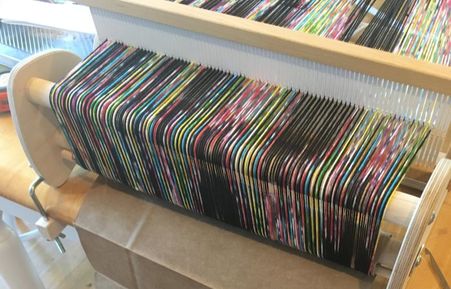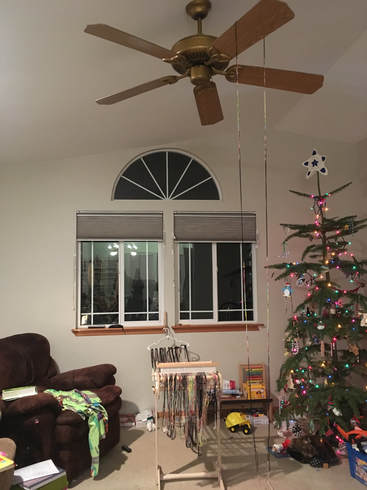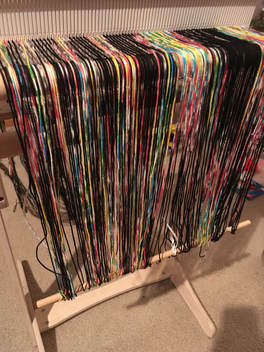|
The title of this blog post is a quote from Adam Savage, probably best known for his role as a co-host on the TV show Mythbusters ("Am.... I... missing an eyebrow?") And it's also a philosophy I'm working hard to adopt in my fiber arts projects, because failure is a pretty powerful process if you choose to use it to learn and move forward. I'm going to take a philosophical diversion for a second. Owning a fiber arts shop means choosing to be a part of a highly image-based industry. Our Instagram, Ravelry, and Facebook feeds are filled with beautiful photos of finished objects, modeled projects, and artful arrangements of new colors and textures. Don't get me wrong - that's important! Good photos mean that there's careful, professional consideration of an aesthetic, and consistency in image and aesthetic build trust, which make you (and us as a shop) want to work with and use those products. But there's a reason that lots of us really enjoy blooper reels and behind-the-scenes photos - we appreciate the artful, but we value the down-and-dirty, in-the-trenches perspectives that show that your favorite designers and dyers and shop owners are real people, too. Working with so many beginning crafters (and students, back in my career as a classroom teacher) over the years has proven one thing: it's ALSO vital to our industry to show that things... go wrong sometimes. For everyone. And we use those failures to reset our brains, examine what happened, think of how to fix it (or how to improve next time), and move on with the knowledge and reflection that we've gained. I share lots of stories of my failures with customers, and I own those failures. Because failure is an incredibly powerful teaching tool. And so, gentle blog readers, I present the story of The Rainbow Scarf. You might remember The Rainbow Scarf from Instagram. Customers asked me to weave something on the shop's rigid heddle loom. I accepted the challenge and had folks vote on colors; it was a close contest, but the Rainbow in the Dark colorway from The Fiber Seed was the winner. I posted excitedly about setting up the loom and getting started on the weaving process. This is one of the outtakes from that series. More experienced weavers in the audience will immediately notice the problem with the grocery bags that I cut to separate warp layers. (For my fellow rookie weavers: let me save you hours of frustration with one tip. Just go ahead and use something that spans the entire width of the back beam. Kraft paper, mini-blind slats, paint stirrers, it doesn't matter. Just don't skimp on that part of the process.) I merrily continued along, winding on my warp, snapping pictures, and sitting down to start weaving almost immediately. Blissfully ignorant of the mess I was getting myself into. I wove. I noticed that the edges of my warp were a little inconsistent. And tight. Well, a little tight is fine, right? Okay. As I continued, those edges got bowstring-tight. To the point where I was afraid the edges of the warp might snap. I put the loom aside for a couple of days, came back to it, and realized that the edges weren't great. And I wanted to have this as a shop sample. So I decided to undo the weft - about 18" worth, but hey. Weaving is quick, right? Right. I got back to the beginning and found this. Again, the experienced weavers in the audience are groaning and putting their heads in their hands as they look at the left side of the warp. (To my fellow rookie weavers: this is not what it's supposed to look like. This is pretty awful, actually.) By not being attentive to separating my warp layers, the edges (which weren't separated) were tensioned differently from the rest of the warp. That was the cause of the bowstring-tight warp threads at the edges. I looked at that setup, sighed. and realized... that was all gonna have to come out and be redone. This realization took place on the last day of business before our holiday break. So I took the loom home. (Yes, it is buckled into the front seat of my car. Safety first.) I got it home and put it in the living room, because if I had to unwind the warp to its full 84"/213cm length, I had both the room to unwind it and a windowsill on which to clamp the warping peg at the appropriate height. Excellent. I had hatched a recovery plan. We did our holiday thing, and then I immediately got to work. This is where I got overwhelmed. So many ends. So much yarn. Maybe I should resign this to a "dog" warp, cut it off, and toss it. NOPE, my frugal Midwestern upbringing interrupted. THAT IS $65 OF YARN. WASTE NOT, WANT NOT. "Fine," I told my frugal Midwestern upbringing. "I'm still putting it in time-out until I can deal with it." And so it sat, gracing our living room, right next to the Christmas tree, for almost a week. We had storytime. I stared at the loom menacingly as we read about quarry machines. We had meals. The loom might as well have been invited to the table to eat with us, such was its presence in the main public space of our home. On New Year's Eve, I decided to get serious. I untied the surgeon's knots at the front of the loom, had Eric help me hold and separate the warp threads so I could tie them to a coat hanger, put the warping peg on the windowsill, and got prepared to retension the warp. "Is that... yarn... hanging from your ceiling fan?" the astute reader might ask. Yes. Yes, it is. Because as we were retying the warp onto the coat hanger, Eric looked at everything. "These are supposed to go space-slot, space-slot, right?" I looked at him suspiciously. "Yes..." "Um. Hmmm. You've got two here that go space-space, slot-slot." I'll spare you the uncouth language that I used to describe the situation in that very moment, but let's just say that it was time for a brief time-out, a glass of water, and taking a moment to stand directly in front of the Christmas tree to admire it. With my back to the loom. Then it was back to work. We got it rethreaded, and there was cautious optimism. We repurposed several household items to get things back under tension again (not pictured: the chunk of 2"x4" lumber that Eric tied to the back apron rod to provide a counterweight). Eric also used a saw to cut down a roll of kraft paper to the precise width necessary to cover the entire warp beam of the loom, which is what I should have had him do in the first place. After retensioning, setting up the kraft paper, and winding the warp back on, we had a nice-looking result. (The loom is tilted down on its stand here to give more of an overhead view. But I assure you that it was a much healthier and happier loom than when it arrived at our house.) And that, folks, is how I fixed an utter failure at warping a rigid heddle loom. There was much cursing. There was a brief period of absolute resentment of the entire project. But failure is always an option. It's what you do with the failure that shapes the project, your learning, and your progress as a fiber artist. (And if you need help MacGyvering your failure into success, swing by your local yarn shop. They have resources and - more likely than not - actual similar experiences to what you've done.)
Postscript: I'm happy to report that the Rainbow Scarf is now completed and on display in the shop - but that will be a blog post for next week. Have an excellent weekend, everyone!
0 Comments
|
AuthorLindsey Spoor is the owner of Stilly River Yarns in Stanwood, WA. Archives
April 2024
Categories |
Reach out! |
Come visit us at our brick-and-mortar shop in Stanwood!
NEW LOCATION STARTING JULY 16, 2024:
7104 265th St. NW Suite 120 Stanwood, WA 98292 Shop phone: (360) 631-5801 Email: [email protected] Text: (515) 833-0689 |
|
|
Proudly powered by Weebly
Stilly River Yarns LLC
Copyright © 2024
Copyright © 2024









 RSS Feed
RSS Feed